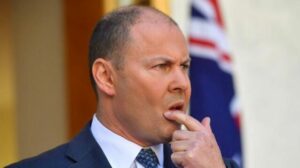Home » Commentary » Opinion » The economic statement: the real issues
· SPECTATOR FLAT WHITE

 The Treasurer’s ministerial statement to parliament yesterday – in place of the usual budget speech scheduled for that day — could have been expected to shed light on three aspects of the current crisis: the economic situation and outlook; the fiscal costs and the outlook for public debt; and policies for recovery.
The Treasurer’s ministerial statement to parliament yesterday – in place of the usual budget speech scheduled for that day — could have been expected to shed light on three aspects of the current crisis: the economic situation and outlook; the fiscal costs and the outlook for public debt; and policies for recovery.
On the economic situation and outlook, Frydenberg provided a litany of dismal statistics. Coming from a government, this slant to the negative was as novel as the coronavirus itself, and surely the opposite of what we would have heard in a budget speech. Frankness is the beneficiary when the disaster clearly is not the government’s own fault.
Even so, Frydenberg’s mix of weekly costs to GDP from the COVID-19 related restrictions ($4 billion) and monthly benefits from easing those restrictions ($9.4 billion) was somewhat confusing. If we interpolate from the information provided and simplify, he seemed to be saying that if GDP in the March quarter was 500, then in the June quarter (most of it with full restrictions) it will be about 450 and in the September quarter (with restrictions eased to create what the government calls the COVID-safe economy) it will recover to about 475.
While the Treasurer took a glass-half-full view of these numbers, quite clearly a glass-half-empty view is also possible. A 5% shortfall from pre-pandemic GDP is better than a 10% shortfall, but it is still worse than any peak-to-trough decline in the 60-year history of quarterly national accounts and points to unemployment remaining very high.
This draws attention to the enduring costs of the sudden economic stop in late March – the costs that won’t easily go away as the switch is flicked back to ‘on’. Some of those costs – such as from investments that did not take place and the struggle for some workers to re-enter the labour force – will last many months and some forever. The 5% shortfall also draws attention to the cost of restrictions that remain in the COVID-safe economy, such as the absence of overseas travel and the ban on large gatherings. If those restrictions remain until a vaccine is developed, the costs will be enormous.
Frydenberg had less to say about revised deficit and debt estimates, merely noting that the deficit to March was $10 billion more than expected in the mid-year budget review last December, and that debt on issue was $50 billion higher as at May 8. There will be more on this in the June statement to parliament. In the meantime, one of the most reliable non-government sources of budget estimates – Deloitte Access Economics – has estimated budget deficits totalling $359 billion across four fiscal years, most of it this year and next.
On the policies for a full recovery to erase that 5% shortfall and more, Frydenberg said all the right things – not increasing taxes; implementing productivity-enhancing reform; applying fiscal discipline; removing the emergency budget rescue measures as soon as possible; looking to the private sector rather than government spending – but was short on specifics. The hard part will be translating those good intentions into specific actions supported by legislation where needed. While that will be a drawn-out process, the start should come soon.
Robert Carling is a Senior Fellow at the Centre for Independent Studies.
The economic statement: the real issues